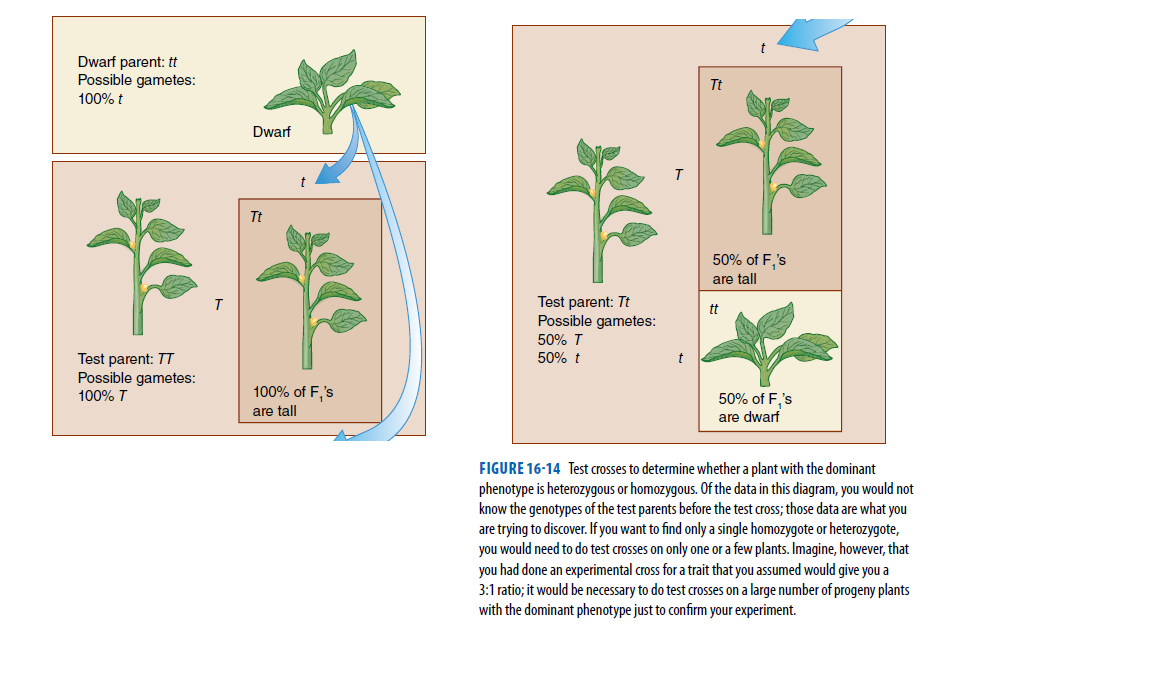Dwarf parent: t Possible gametes: Tt 100% t Dwarf Tt 50% of F,'s are tall Test parent: Tt Possible gametes: tt 50% T 50% t Test parent: TT Possible gametes: 100% T t 100% of F,'s 50% of F,'s are tall are dwarf FIGURE 16-14 Test crosses to determine whether a plant with the dominant phenotype is heterozygous or homozygous. Of the data in this diagram, you would not know the genotypes of the test parents before the test cross; those data are what you are trying to discover. If you want to find only a single homozygote or heterozygote, you would need to do test crosses on only one or a few plants. Imagine, however, that you had done an experimental cross for a trait that you assumed would give you a 3:1 ratio; it would be necessary to do test crosses on a large number of progeny plants with the dominant phenotype just to confirm your experiment.
Dwarf parent: t Possible gametes: Tt 100% t Dwarf Tt 50% of F,'s are tall Test parent: Tt Possible gametes: tt 50% T 50% t Test parent: TT Possible gametes: 100% T t 100% of F,'s 50% of F,'s are tall are dwarf FIGURE 16-14 Test crosses to determine whether a plant with the dominant phenotype is heterozygous or homozygous. Of the data in this diagram, you would not know the genotypes of the test parents before the test cross; those data are what you are trying to discover. If you want to find only a single homozygote or heterozygote, you would need to do test crosses on only one or a few plants. Imagine, however, that you had done an experimental cross for a trait that you assumed would give you a 3:1 ratio; it would be necessary to do test crosses on a large number of progeny plants with the dominant phenotype just to confirm your experiment.
Concepts of Biology
1st Edition
ISBN:9781938168116
Author:Samantha Fowler, Rebecca Roush, James Wise
Publisher:Samantha Fowler, Rebecca Roush, James Wise
Chapter8: Patterns Of Inheritance
Section: Chapter Questions
Problem 2ACQ: Figure 8.10 In pea plants, purple flowers (P) are dominant to white (p), and yellow peas (Y) are...
Related questions
Topic Video
Question
When traits show complete dominance, the genotype can be revealed by a test cross. In the example of tall and dwarf plants (Figure) why is it necessary to use the dwarf parent? In general, why is it necessary to use a parent that is homozygous recessive?

Transcribed Image Text:Dwarf parent: t
Possible gametes:
Tt
100% t
Dwarf
Tt
50% of F,'s
are tall
Test parent: Tt
Possible gametes:
tt
50% T
50% t
Test parent: TT
Possible gametes:
100% T
t
100% of F,'s
50% of F,'s
are tall
are dwarf
FIGURE 16-14 Test crosses to determine whether a plant with the dominant
phenotype is heterozygous or homozygous. Of the data in this diagram, you would not
know the genotypes of the test parents before the test cross; those data are what you
are trying to discover. If you want to find only a single homozygote or heterozygote,
you would need to do test crosses on only one or a few plants. Imagine, however, that
you had done an experimental cross for a trait that you assumed would give you a
3:1 ratio; it would be necessary to do test crosses on a large number of progeny plants
with the dominant phenotype just to confirm your experiment.
Expert Solution
This question has been solved!
Explore an expertly crafted, step-by-step solution for a thorough understanding of key concepts.
Step by step
Solved in 2 steps

Knowledge Booster
Learn more about
Need a deep-dive on the concept behind this application? Look no further. Learn more about this topic, biology and related others by exploring similar questions and additional content below.Recommended textbooks for you

Concepts of Biology
Biology
ISBN:
9781938168116
Author:
Samantha Fowler, Rebecca Roush, James Wise
Publisher:
OpenStax College

Human Heredity: Principles and Issues (MindTap Co…
Biology
ISBN:
9781305251052
Author:
Michael Cummings
Publisher:
Cengage Learning

Concepts of Biology
Biology
ISBN:
9781938168116
Author:
Samantha Fowler, Rebecca Roush, James Wise
Publisher:
OpenStax College

Human Heredity: Principles and Issues (MindTap Co…
Biology
ISBN:
9781305251052
Author:
Michael Cummings
Publisher:
Cengage Learning